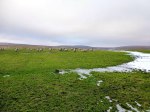OS grid reference: SD 84829 41718. For want of a better name I am calling this site ‘Aedmar’s Mound Earthworks’. These earthworks or ringworks are located down in a narrow valley, in a field above Blacko Water, near Wheathead Lane, just to the west of Blacko and Gisburn road, Lancashire, in the area called Admergill. A trackway heads off from Wheathead Lane at the bridge and then goes in a south-westerly direction for a short distance, and eventually through a wall stile – the earthworks are in the field (here) at the western-side of the beck – being noticeable by the grassy rectangular mound with its accompanying low ramparts, known as ringworks. These now rather forgotten earthworks may date back to the Iron-Age, or from the so-called Dark-Ages, or from the early Medieval period, but other than that we do not know when these earthworks were built or what they actually were; and they are not marked on any Ordnance Survey maps.
The earthworks cover an area of approx. 94m across N-S and 60m diagonally W-S though the S and N sides are cut-off and damaged by the farmer’s ‘modern’ field system, while at the NW side of the site there is a continuation of the low ringwork ramparts. The rectangular-shaped low mound ‘with the telegraph pole’ is quite a distinctive shape, but there are actually two mounds here – both being intersected in the middle by a deep ditch, or entrance. So what was it exactly? Was it a camp, a hillfort, or a defended site? Or was there a settlement here or maybe a royal residence of some kind? There appears to be at least three circular ramparts or ring-works and, possibly a fourth ring by the looks of it, surrounding the low, grassy elevated mound, and the same again at the far NW side but in a sort of square-shape, which has been cut off from the main site, possibly due to farming, or that it was meant to be like this?
Local author, John Clayton, in his fascinating book ‘Valley of the Drawn Sword’, says that Admergill could possibly take its name from: “the Welsh prince A’dd Maur who controlled certain British lands sometime in the Early Medieval period, it is very possible that this name has been shortened over time to Mawr….but equally, it could apply to the nearby settlement of Admergill…..which eventually leads to A’dd Mawr’s Gill.”
But what of Aedmar and Eadmer two names that may be connected with this area, in which our ancient site lies. St Aedmer or Eadmer was a bishop, ecclesiastic, and theologian who died in 1126, and was a friend of St Anselm. Was it “he” who gave his name to Admergill. And, there was a 7th century St Eadmer, a Northumbrian monk and disciple of St Cuthbert. But the truth is we don’t know, and probably never will – the name being lost in the mists of time. I think we should, therefore, say that the Welsh prince A’dd Mawr (Athmawr) is the more liklely contender here. He may have ruled over the Celtic (British) kingdom of Craven – Admergill being at the southern edge of this northern kingdom. And 2 miles to the north we have a farm called Craven Laithe!
About 1 mile to the north on the southern side of Burn Moor a bowl-shaped quern stone was found, dating from 300-400 BCE (the middle Iron-Age). Grain would have been rubbed in the central depression with a small, rounded stone or pestle. In the vicinity of this discovery there were found to be a number of ancient boulders, some being built into walls (Clayton, John A, 2006).
Sources:
Clayton, John A., The Valley of the Drawn Sword – The Early History of Burnley, Pendle and West Craven, Barrowford Press, 2006.
Dixon, John & Mann, Bob, Historic Walks Around The Pendle Way, Aussteiger Publications, Barnoldswick, 1990.






